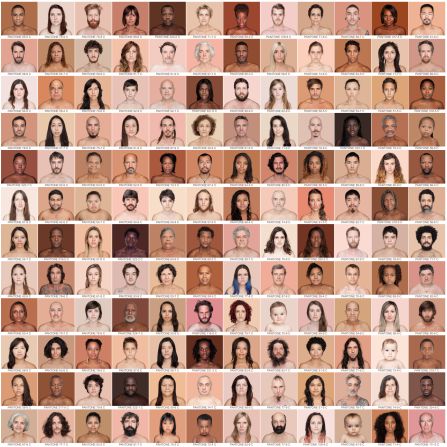
Human?: Skin tones matched to Pantone printing cards —
Photographer Angelica Dass says she doesn't believe she'll ever capture every shade of human skin. But after shooting 2,500 portraits she has come closer than any other person to cataloging how far the spectrum of human skin extends.
![Her project <a target="_blank" target="_blank"><em>Human?</em></a><em> </em>is a "chromatic inventory," explains Dass, based on "a series of portraits whose background is dyed with the exact Pantone [printing color chart] tone extracted from a sample of 11x11 pixels of the portrayed's face."](https://media.cnn.com/api/v1/images/stellar/prod/150430150029-humanae-316-5-c1.jpg?q=w_1422,h_800,x_0,y_0,c_fill/h_447)
Her project Human? is a "chromatic inventory," explains Dass, based on "a series of portraits whose background is dyed with the exact Pantone [printing color chart] tone extracted from a sample of 11x11 pixels of the portrayed's face."

Despite 3 years' work, spanning the world, shooting in 12 cities from Daegu, South Korea to Valparaiso, Chile, 36-year-old Dass believes the project still has a long way to go yet. "Human? is a work in progress," she says, "...infinite and unfinished."

This simple concept has a subtle goal. "It is a kind of game for subverting our codes," says the artist, explaining that no reference is made anywhere to the subject's "nationality, origin, economic status, age or aesthetic standards."

Backed by the color chart, the series is able to diminish the importance of race, explains Spanish curator Alejandro Castellote -- creating instead "a degree of hierarchical horizontality that dilutes the false preeminence of some races over others based on skin color or social condition." (emphasis added)

All those photographed are volunteers, explains Dass, who travel to one of her shoots -- which have also taken place in Madrid, Addis Ababa, and Rio de Janeiro -- be part of the show. Models often bring with them surprising new lessons for the artist, she explains.

"I make discoveries all the time photographing," says Dass. "Regarding Human?, the first is: what motivates more than 2500 unknown people to participate in a project like this?"

Here, she finds an answer in the project's fundamental narrative power: "Because in this work is 'the others' who are telling my history, that finally are their own stories."

The project is currently on exhibition at the Gund Gallery in Gambier, Ohio -- it has already traveled the world from Valencia, Spain to Lagos, Nigeria -- and over 2000 portraits can be seen online at the Human? tumblr.

The series started as Dass' submission for her masters degree in photography. Her family -- Brazilians with diverse cultural and racial backgrounds -- acted as the first models.

Since Dass began to share the portraits on Tumblr, the project has taken on a life of its own: "Human? has generated a lot of areas, materials, attitudes, knowledge and human meaning, expression, communication...out of my control and that were not originally planned," she says.

The artist says she has seen it be used by scientists to discuss how human sight works, and "in educational textbooks, by teachers who make Human? a tool to talk about equality or anthropological realities."

It has even been used by adoptive families to "help children to identify themselves as unique."

"I'm collecting stories," says Dass. "And this is as important as collecting images."

The photographer says the project could only be completed by portraying "all of mankind," but in the shorter term she hopes to hold photographic sessions on each continent, and to broadening representation as far as possible.

As the project develops it takes in more colors, and her all encompassing vision is gradually becoming clear, after some questions were raised

"In the beginning of the project I have received mail with criticism, focusing on the lack of ethnic diversity in the project."

"A U.S. Senator said that they 'love Humanae,' but that they were disappointed that the rich dark colors of Central Africa and India are not shown and that they hope they get at least as much attention as the European shades."
![Dass says she believes the projects has connected the subjects together. Her ultimate goal is to create "a discussion platform on identity," creating images that provoke us to see ourselves in them. "We all have this desire [for] "humanity" in common."](https://media.cnn.com/api/v1/images/stellar/prod/150430150259-humanae-70-6-c.jpg?q=w_1422,h_800,x_0,y_0,c_fill/h_447)
Dass says she believes the projects has connected the subjects together. Her ultimate goal is to create "a discussion platform on identity," creating images that provoke us to see ourselves in them. "We all have this desire [for] "humanity" in common."

To see over 2000 portraits, go to the Human? tumblr.